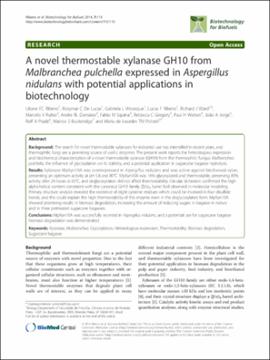| dc.contributor.author | Ribeiro, Liliane F. C. | |
| dc.contributor.author | De Lucas, Rosymar C. | |
| dc.contributor.author | Vitcosque, Gabriela L. | |
| dc.contributor.author | Ribeiro, Lucas F. | |
| dc.contributor.author | Ward, Richard J. | |
| dc.contributor.author | Rubio, Marcelo V. | |
| dc.contributor.author | Damasio, Andre R. L. | |
| dc.contributor.author | Squina, Fabio M. | |
| dc.contributor.author | Gregory, Rebecca C. | |
| dc.contributor.author | Walton, Paul H. | |
| dc.contributor.author | Jorge, Joao A. | |
| dc.contributor.author | Prade, Rolf A. | |
| dc.contributor.author | Buckeridge, Marcos S. | |
| dc.contributor.author | Polizeli, Maria de Lourdes T. M. | |
| dc.date.accessioned | 2018-11-09T21:10:53Z | |
| dc.date.available | 2018-11-09T21:10:53Z | |
| dc.date.issued | 2014-07-29 | |
| dc.identifier | oksd_ribeiro_anovelthermosta_2014 | |
| dc.identifier.citation | Ribeiro, L. F. C., De Lucas, R. C., Vitcosque, G. L., Ribeiro, L. F., Ward, R. J., Rubio, M. V., ... Polizeli, M. L. T. M. (2014). A novel thermostable xylanase GH10 from Malbranchea pulchella expressed in Aspergillus nidulans with potential applications in biotechnology. Biotechnology for Biofuels, 7, Article 115. https://doi.org/10.1186/1754-6834-7-115 | |
| dc.identifier.uri | https://hdl.handle.net/11244/302067 | |
| dc.description.abstract | Background: The search for novel thermostable xylanases for industrial use has intensified in recent years, and thermophilic fungi are a promising source of useful enzymes. The present work reports the heterologous expression and biochemical characterization of a novel thermostable xylanase (GH10) from the thermophilic fungus Malbranchea pulchella, the influence of glycosylation on its stability, and a potential application in sugarcane bagasse hydrolysis. | |
| dc.description.abstract | Results: Xylanase MpXyn10A was overexpressed in Aspergillus nidulans and was active against birchwood xylan, presenting an optimum activity at pH 5.8 and 80°C. MpXyn10A was 16% glycosylated and thermostable, preserving 85% activity after 24 hours at 65°C, and deglycosylation did not affect thermostability. Circular dichroism confirmed the high alpha-helical content consistent with the canonical GH10 family (β/α)8 barrel fold observed in molecular modeling. Primary structure analysis revealed the existence of eight cysteine residues which could be involved in four disulfide bonds, and this could explain the high thermostability of this enzyme even in the deglycosylated form. MpXyn10A showed promising results in biomass degradation, increasing the amount of reducing sugars in bagasse in natura and in three pretreated sugarcane bagasses. | |
| dc.description.abstract | Conclusions: MpXyn10A was successfully secreted in Aspergillus nidulans, and a potential use for sugarcane bagasse biomass degradation was demonstrated. | |
| dc.format | application/pdf | |
| dc.language | en_US | |
| dc.publisher | BioMed Central | |
| dc.rights | This material has been previously published. In the Oklahoma State University Library's institutional repository this version is made available through the open access principles and the terms of agreement/consent between the author(s) and the publisher. The permission policy on the use, reproduction or distribution of the material falls under fair use for educational, scholarship, and research purposes. Contact Digital Resources and Discovery Services at lib-dls@okstate.edu or 405-744-9161 for further information. | |
| dc.title | Novel thermostable xylanase GH10 from Malbranchea pulchella expressed in Aspergillus nidulans with potential applications in biotechnology | |
| osu.filename | oksd_ribeiro_anovelthermosta_2014.pdf | |
| dc.description.peerreview | Peer reviewed | |
| dc.identifier.doi | 10.1186/1754-6834-7-115 | |
| dc.description.department | Microbiology and Molecular Genetics | |
| dc.type.genre | Article | |
| dc.type.material | Text | |
| dc.subject.keywords | xylanase | |
| dc.subject.keywords | malbranchea | |
| dc.subject.keywords | glycosylation | |
| dc.subject.keywords | heterologous expression | |
| dc.subject.keywords | thermostability | |
| dc.subject.keywords | biomass degradation | |
| dc.subject.keywords | sugarcane bagasse | |
